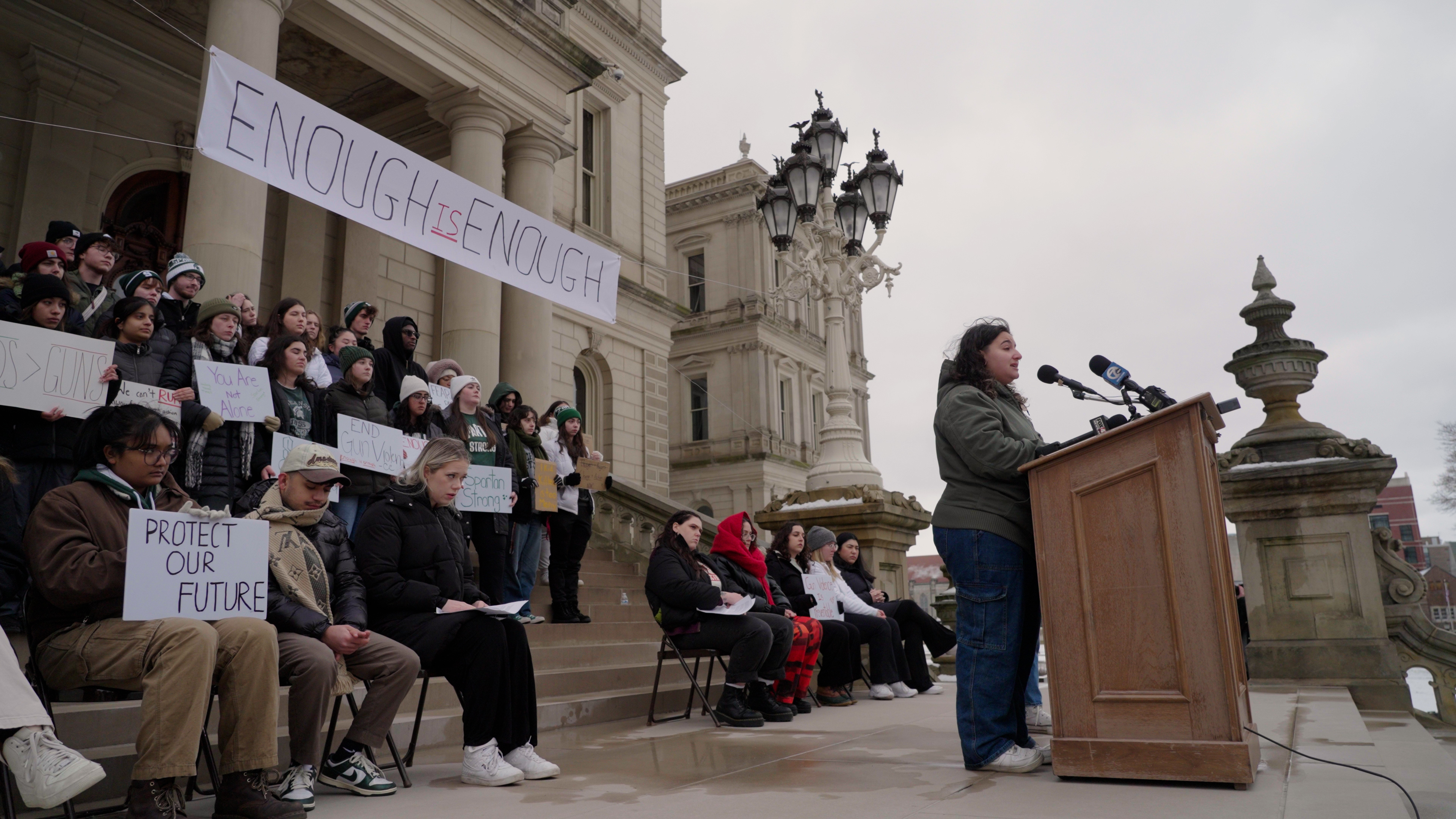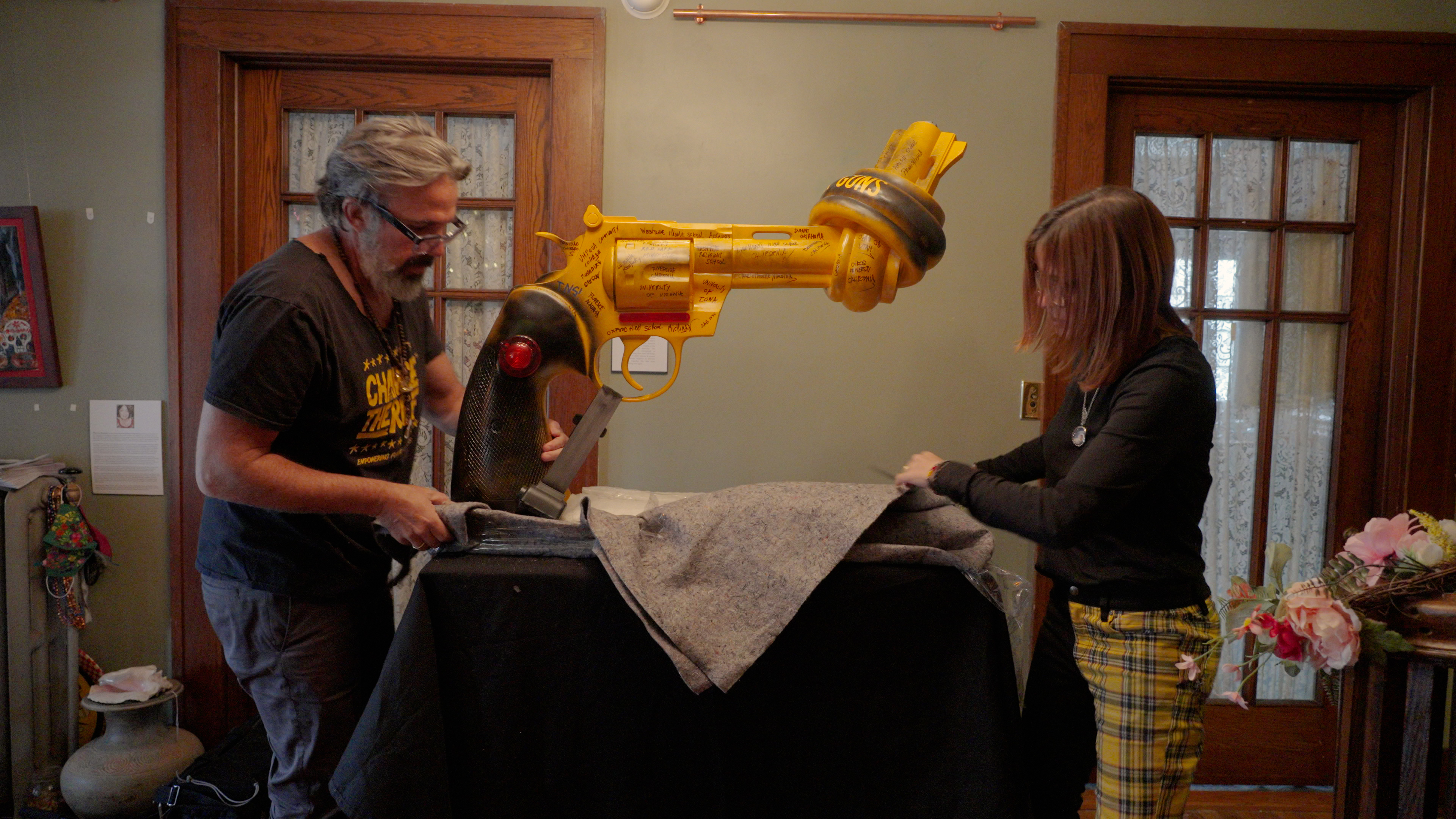The 2024 Humanities and Arts Research Program (HARP) Large-Scale Development Grant has been awarded to Scott Boehm and Peter Johnston, to produce the feature-length documentary OUR KNOTTED GUN. Scott Boehm, an assistant professor of Spanish and global studies, and affiliated faculty in the Film Studies program in the college of Arts & Letters at MSU, will be working with Peter Johnston, an academic specialist and digital media/film production manager in the Film Studies program. Designed to reach national and international audiences, this documentary will explore the national epidemic of gun violence in the U.S., touching on aspects of it that make this a global issue through the lens offered by many individuals who have different perspectives and approaches to addressing the problem of gun violence.
Funded through the MSU Research Foundation and Office of Research and Innovation, HARP grants are designed to support faculty engaged in arts and humanities projects. The HARP Large-Scale project grant funds exceptional and substantial creative and performance-based projects, supporting faculty in developing projects that are likely to lead to global distribution and enhance the reputation of the faculty member and MSU.

MSU student Maya Manuel speaks at the Michigan capitol building on February 15, 2024, the one-year anniversary of her original “Sit Down MSU” protest. Photo by Peter Johnston
The pervasive effects of gun violence are far-reaching and hit close to home. OUR KNOTTED GUN explores historical aspects of how, as a society, we have reached this crisis point and explores differing perspectives on how to address gun violence. Several storylines weave a rich tapestry of personal experiences featured in the film, with the MSU campus serving as a key site for the documentary. The tragedy of February 13, 2023 strongly impacted the community, prompting difficult conversations and inspiring others to action. Interwoven are stories from MSU students, such as Saylor Reinders, the co-leader of Students Demand Action, and Maya Manuel, founder of Sit-Down MSU, together with local voices like Lansing community member Michael Lynn, Jr., who has started several initiatives, including The Village Lansing, The Advocates Firearms Academy, and Lansing 360°, which are bringing a variety of stakeholders together to address community gun violence.
Additional nationally prominent figures incorporated into the film include David Hogg, survivor of the Parkland massacre and co-founder of March for Our Lives, as well as Manny and Patricia Oliver, parents of one of the Parkland victims and founders of Change the Ref.
Spurred into action following the tragedy on campus, Boehm and Johnston came together to develop this project. As filmmakers, they saw an opportunity to create a documentary film, not to reconstruct what happened on campus or have a debate on the second amendment, but to hear from the many voices touched by gun violence. As a concerned parent, Boehm listened to and was moved by the voices of the lockdown generation sharing their experiences at the Michigan state capitol during one of the sit-down protests organized by Manuel in the wake of the February 13th tragedy. Through these collective voices and ideas, Boehm and Johnston are focused on the solutions and ideas different people bring to the table and finding voices one may not expect to hear in these discussions.
Through this film, we seek to challenge much of what passes for common sense when it comes to U.S. gun culture and attempts to regulate it by examining this public health crisis from a variety of perspectives that defamiliarize typical ways of seeing a long-standing problem that has become the leading killer of children and young people in the United States in recent years. Having spent much of my adult life outside the United States, I know what an aberration the U.S. is when it comes to gun violence, and we want to make a film that reflects the tragic absurdity that passes for normal here, while offering glimmers of hope that spring from individual and community outrage at the status quo, as well as other national experiences.Scott Boehm
Gun violence has been a knotty, thorny problem for generations, one that is hard to unravel. The title of the film OUR KNOTTED GUN is intentionally in the first-person plural. Practically everyone is affected by gun violence in some way, and we all have a duty to be a part of the solution. Since there is no easy fix, all voices need to come together to figure out what will work for our society. The title of the film also references the well-known sculpture of a handgun, Non-Violence, that is tied into a knot, rendering the gun useless as a weapon. A visual motif throughout the film, this sculpture takes the symbol of the gun and through the addition of the knot, the meaning of the gun symbol starts to change.
The Non-Violence Project uses replicas of this sculpture for trauma-informed programming initiatives directed at youth and communities. OUR KNOTTED GUN explores one program, Why Knot NY? at Lehman High School in the Bronx, NY. Applying sociodrama and art therapy exercises based on principles of restorative justice, students describe their interpretations of the sculpture. Using replicas, the students reinterpret their own knotted gun sculpture. Trauma-informed exploration and introspection around this artwork and gun violence help the group of students learn from one another and serves as a connecting thread thematically and symbolically for the film.
Using a global perspective allows for thoughtful cultural comparisons to and critiques of the many aspects of gun violence and gun culture in the U.S. Inspired by the testimony at the Michigan Senate of Marco Díaz-Muñoz, assistant professor in the department of Romance and Classical Studies, whose classroom was at the center of the tragedy at MSU, the film explores the global reach of gun violence through its victims and other international connections. Díaz-Muñoz, originally from Costa Rica, shared with Boehm and during testimony his experience growing up outside of the U.S. and the changes in culture he has witnessed as it relates to gun violence.
Using prior experience with survivor testimony in the context of the Spanish Civil War, Boehm takes care to put what’s happening in the U.S. into a global context, giving OUR KNOTTED GUN a perspective unique to this film when compared to other films concerning gun violence.

Here, artist/activist Manny Oliver and his partner Patricia Oliver unpack his interpretation of the knotted gun sculpture, done in a school bus motif, in preparation for its display at his one-man show in Lansing on February 17, 2024. Non-Violence, by Swedish artist Carl Fredrik Reuterswärd, was designed in response to the assassination of John Lennon in 1980 to honor Lennon’s vision for global peace. A bronze version of the sculpture was donated by the government of Luxembourg to the Non-Violence Project and unveiled in 1988 in front of the United Nations in New York and serves as the official symbol for peace and non-violence at the United Nations. Since then, more than 30 replicas have been placed around the world, and the sculpture has served as inspiration for artists and activists around the world. Photo by Peter Johnston.
Boehm and Johnston are careful to consider both the conceptual and formal elements of OUR KNOTTED GUN. Formal decisions, including using a wide-angle format with a full-frame camera, were made to visually convey the magnitude of the problem. Dialogue from different countries is presented in their natural languages, emphasizing the global reach of gun violence. Additional trauma-informed decisions in the making of the film include the possibility of replacing footage of actual violence with animation. This approach is out of respect for victims and survivors of violence and would distinguish OUR KNOTTED GUN from typical media coverage that has led viewers to become desensitized to violence.
Developing a documentary film is a long and costly undertaking. The process to find funding partners and sponsors requires the filmmakers to create something to show others who can get on board and support the project to get it fully developed. The HARP Large-Scale Grant gives Boehm and Johnston a substantial boost in this area, getting them partially to their goal, toward which they continue to crowd fund for additional support.
Having the access to and the opportunity to apply for a $100,000 grant for a film is just, it’s enormous…and now that we have been granted that…that really opens the door then to do a lot. It allows us to get to a point where we can then show other funders that this is a serious project, it’s got a significant, huge amount of backing and we’re doing the thing that we said we would do. So it’s not just an idea, but it’s in progress and it’s happening.Peter Johnston
OUR KNOTTED GUN will be primed for national and international distribution, with Boehm and Johnston securing the rights to use the Non-Violence sculpture and imagery to connect with audiences. Production and community impact partners for OUR KNOTTED GUN include Partisan Pictures and the Non-Violence Project, both of whom have high-profile connections within the media and entertainment industry, which will help give the film a national television audience. National and international film festivals are planned for 2026, and the film is projected to secure distribution through major streaming platforms and/or a major educational distributor by 2027. For more information, please visit the OUR KNOTTED GUN website.
This film is a great example of why we designed and launched the HARP Large-Scale Grant program. The program allows us to support faculty doing inspiring research and innovative projects at a level that will lead to wide circulation, visibility, and recognition for our faculty and their work. Through this significant seed funding, we create the opportunity to distinguish MSU as an organization that innovatively supports inspired and thought-provoking proposals in the humanities and the arts. I aspire to do more to help MSU lead in the performance and creative arts and suspect that with some success from the three projects we have funded so far, we will find a way to bring more resources to the table.Charles A. Hasemann, Ph.D., associate vice president for Innovation and Economic Development
Story by Tanya Bakija
